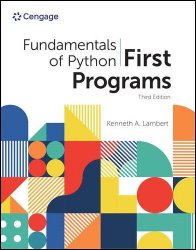Fundamentals Of Python: First Programs (MindTap Course List), 3rd Edition
- Добавил: literator
- Дата: 2-06-2024, 15:12
- Комментариев: 0
 Название: Fundamentals Of Python: First Programs (MindTap Course List), 3rd Edition
Название: Fundamentals Of Python: First Programs (MindTap Course List), 3rd EditionАвтор: Kenneth A. Lambert
Издательство: Cengage Learning
Год: 2024
Страниц: 482
Язык: английский
Формат: pdf (true)
Размер: 10.1 MB
Master today's required Computer Science topics while preparing for further study with Lambert's FUNDAMENTALS OF PYTHON: FIRST PROGRAMS. This book's easygoing approach is ideal, no matter what your background. The approach starts with simple algorithmic code and then scales into working with functions, objects, and classes as the problems become more complex and require new abstraction mechanisms. Rather than working only with numeric or text-based applications like other introductory texts, this edition presents graphics, image manipulation, GUIs, and simple networked client/server applications. The author uses Python's standard Turtle graphics module to introduce graphics and to provide open source frameworks for easy image processing and GUI application development.
This book covers five major aspects of computing:
1. Programming basics - Data types, control structures, algorithm development, and program design with functions are basic ideas that you need to master in order to solve problems with computers. This book examines these core topics in detail and gives you practice employing your understanding of them to solve a wide range of problems.
2. Object-oriented programming (OOP) - Object-oriented programming is the dominant programming paradigm used to develop large software systems. This book introduces you to the fundamental principles of OOP and enables you to apply them successfully.
3. Data and information processing - Most useful programs rely on data structures to solve problems. These data structures include strings, arrays, files, lists, and dictionaries. This book introduces you to these commonly used data structures and includes examples that illustrate criteria for selecting the appropriate data structures for given problems.
4. Software development life cycle - Rather than isolate software development techniques in one or two chapters, this book deals with them throughout in the context of numerous case studies. Among other things, you’ll learn that coding a program is often not the most difficult or challenging aspect of problem solving and software development.
5. Contemporary applications of computing - The best way to learn about programming and problem solving is to create interesting programs with real-world applications. In this book, you’ll begin by creating applications that involve numerical problems and text processing. For example, you’ll learn the basics of encryption techniques, such as those that are used to make your credit card number and other information secure on the Internet. But unlike many other introductory texts, this one does not restrict itself to problems involving numbers and text. Most contemporary applications involve graphical user interfaces, event-driven programming, graphics, image manipulation, network communications, and data analysis. These topics are not consigned to the margins but are presented in depth after you have mastered the basics of programming.
Why Python? Computer technology and applications have become increasingly more sophisticated over the past three decades, and so has the computer science curriculum, especially at the introductory level. Today’s students learn a bit of programming and problem solving and are then expected to move quickly into topics like software development, complexity analysis, and data structures that 35 years ago were relegated to advanced courses. In addition, the ascent of object-oriented programming as the dominant paradigm of problem solving has led instructors and textbook authors to implant powerful, industrial-strength programming languages such as C++ and Java in the introductory curriculum. As a result, instead of experiencing the rewards and excitement of solving problems with computers, beginning computer science students often become overwhelmed by the combined tasks of mastering advanced concepts as well as the syntax of a programming language. This book uses the Python programming language as a way of making the first year of studying computer science more manageable and attractive for students and instructors alike.
Contents:
Скачать Fundamentals Of Python: First Programs (MindTap Course List), 3rd Edition
Внимание
Уважаемый посетитель, Вы зашли на сайт как незарегистрированный пользователь.
Мы рекомендуем Вам зарегистрироваться либо войти на сайт под своим именем.
Уважаемый посетитель, Вы зашли на сайт как незарегистрированный пользователь.
Мы рекомендуем Вам зарегистрироваться либо войти на сайт под своим именем.
Информация
Посетители, находящиеся в группе Гости, не могут оставлять комментарии к данной публикации.
Посетители, находящиеся в группе Гости, не могут оставлять комментарии к данной публикации.

